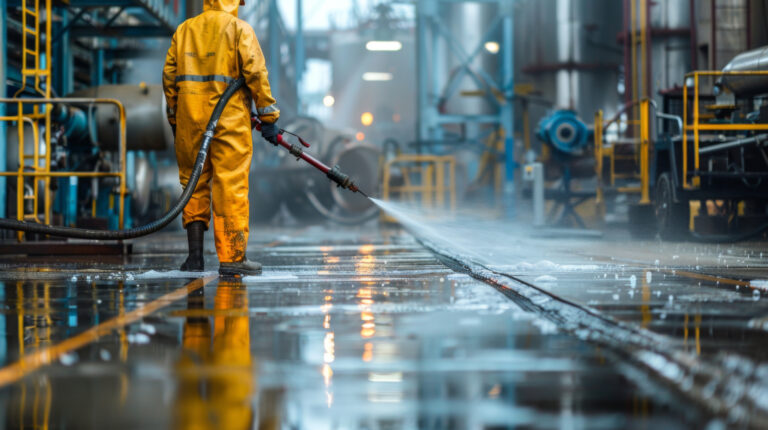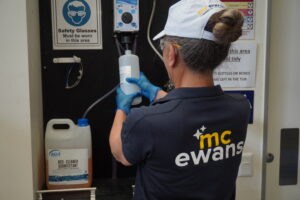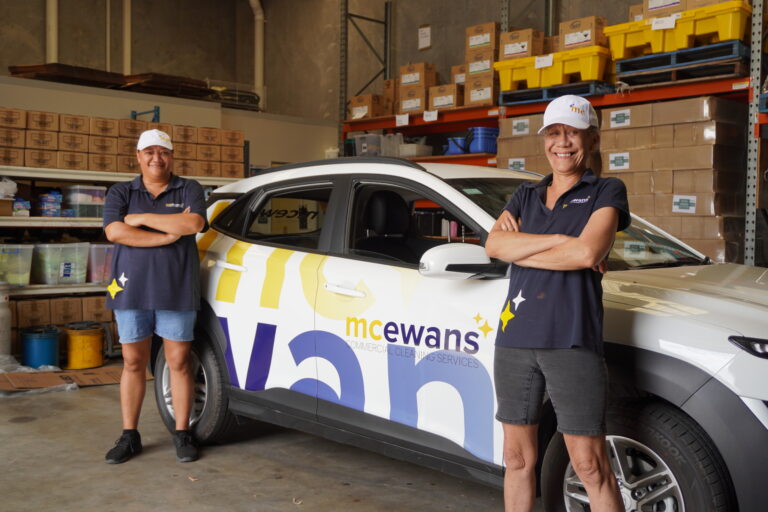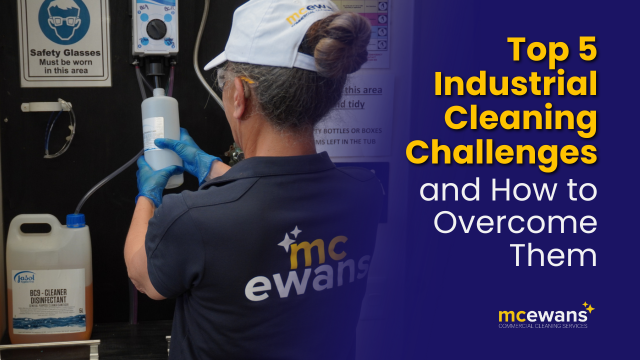
Industrial cleaning is an essential yet complex task for facility managers, cleaning supervisors, and business owners. Keeping industrial environments clean not only ensures the safety and health of employees but also maintains operational efficiency and regulatory compliance.
According to a report by Safe Work Australia, slips, trips, and falls account for thousands of preventable workplace accidents each year, with inadequate cleaning and maintenance often being a contributing factor. In this article, we will delve into the top five challenges that industrial facility managers and cleaning supervisors encounter, and provide practical solutions and best practices to overcome them.
Top 5 Industrial Cleaning Challenges and Best Practices to Solve Them
1. Hard-to-Reach Areas
Industrial facilities often have complex layouts with numerous hard-to-reach areas, such as overhead pipes, ventilation ducts, and tight corners. These areas are prone to accumulating dust, debris, and contaminants, which can affect air quality and pose health risks to employees.
Industrial facilities often have complex layouts with numerous hard-to-reach areas, such as overhead pipes, ventilation ducts, and tight corners. These areas are prone to accumulating dust, debris, and contaminants, which can affect air quality and pose health risks to employees.
A study by the National Institute of Environmental Health Sciences found that poor indoor air quality, often due to unclean HVAC systems, can reduce worker productivity and affect their cognitive functions. Traditional cleaning methods may not be sufficient to thoroughly clean these spaces, leading to potential safety hazards and decreased equipment efficiency.
Solutions and Best Practices
Overcoming the challenge of cleaning hard-to-reach areas requires a combination of specialised equipment and techniques:
Utilise equipment such as high-reach vacuums, extendable cleaning tools, and robotic cleaners designed to access difficult areas. These tools can reach high ceilings, ducts, and other challenging spots without compromising safety.
Safe Work Australia requires representatives of each organisation or business to undertake a relevant approved health and safety training course within 28 days of their election.
Ensure that cleaning staff are properly trained to use specialised equipment and follow safety protocols when accessing hard-to-reach areas. This includes using harnesses, scaffolding, or cherry pickers when necessary.
Implement a regular deep cleaning schedule for these areas to prevent the build-up of contaminants. This proactive approach reduces the risk of long-term damage and maintains a healthier work environment.
2. Heavy Machinery Cleaning
Heavy machinery is a critical component of industrial operations, but cleaning it can be particularly challenging. WorkSafe Australia considers noisy machinery as a hazard that has a potential to harm a person.
Machinery often has intricate parts, sharp edges, and sensitive components that can be easily damaged by improper cleaning methods. Additionally, grease, oil, and other residues can accumulate on machinery, making it difficult to clean without specialised techniques.
Solutions and Best Practices
Effective heavy machinery cleaning requires a delicate balance between thoroughness and caution:
Select cleaning agents that are specifically designed for industrial machinery. These should be strong enough to remove grease and grime but gentle enough not to damage sensitive components. For example, biodegradable solvents are effective at breaking down oils without harming machinery parts.
For intricate machinery parts, manual cleaning using brushes, cloths, and compressed air can be more effective than automated methods. This allows for greater control and precision in cleaning.
As a rule of thumb, maintenance schedule follows a 30-60-90 day interval, according to experts. Establish a regular maintenance and cleaning schedule to prevent excessive build-up of dirt and grease. This not only prolongs the life of the machinery but also ensures it operates efficiently and safely.
3. Hazardous Materials
 Industrial environments often deal with hazardous materials, including chemicals, toxic substances, biohazards, falling or moving objects, and sharp materials. According to the Australian Institute of Health and Welfare (AIHW), there are more than 70,000 hospitalisations related to contact of hazardous objects in 2021-2022 alone. Cleaning these materials poses significant risks to workers and requires stringent safety protocols to prevent accidents, contamination, and regulatory violations.
Industrial environments often deal with hazardous materials, including chemicals, toxic substances, biohazards, falling or moving objects, and sharp materials. According to the Australian Institute of Health and Welfare (AIHW), there are more than 70,000 hospitalisations related to contact of hazardous objects in 2021-2022 alone. Cleaning these materials poses significant risks to workers and requires stringent safety protocols to prevent accidents, contamination, and regulatory violations.
Solutions and Best Practices
Handling and cleaning hazardous materials require meticulous attention to safety and compliance:
Ensure that all cleaning staff are trained and certified in handling hazardous materials. Certifications and training courses are approved under section 21 of Work Health and Safety Regulation 2011. This includes understanding the properties of the substances, proper use of personal protective equipment (PPE), and emergency response procedures.
Utilise cleaning products that are specifically designed to neutralise hazardous materials. For example, using absorbent pads and neutralising agents can safely clean up chemical spills without spreading contaminants.
Adhere to Australian regulations such as the Work Health and Safety (WHS) guidelines, which mandate the proper handling, storage, and disposal of hazardous materials. Regular audits and inspections should be conducted to ensure compliance with these standards.
4. Maintaining Cleanliness in High-Traffic Areas
High-traffic areas, such as entrances, corridors, and common spaces, are prone to rapid accumulation of dirt, debris, and contaminants. These areas can quickly become dirty, posing slip hazards and creating an unsightly appearance, which can negatively impact the morale and safety of employees.
Solutions and Best Practices
Maintaining cleanliness in high-traffic areas requires a proactive approach:
Implement a more frequent cleaning schedule for high-traffic areas. This may involve multiple cleanings throughout the day, especially during peak times.
Place high-quality, durable floor mats at entrances and exits to capture dirt and moisture before it spreads throughout the facility. Regularly clean and replace these mats to ensure effectiveness.
5. Ensuring Compliance with Regulations

Industrial cleaning is governed by a range of regulations designed to protect workers, the environment, and the public, including Safe Work Australia and Work Health and Safety Act 2011. These include regulations related to hygiene, chemical use, waste disposal, and environmental protection. Non-compliance can result in legal penalties, fines, and damage to the company’s reputation.
Solutions and Best Practices
Ensuring compliance with regulations requires a comprehensive and well-documented approach:
Keep up to date with the latest regulations and standards in industrial cleaning, such as the WHS guidelines and environmental protection laws in Australia. Regularly review these standards to ensure that your cleaning practices are in line with current requirements.
Conduct regular internal audits and inspections to identify areas of non-compliance and address them promptly. Engage third-party auditors to provide an objective assessment of your cleaning practices.
Partnering with a professional cleaning service is a strategic solution to ensure compliance with the stringent regulations.
McEwans, a reliable and certified commercial cleaning partner, ensures that their team is trained and thoroughly inducted on relevant WHS protocols. McEwans conducts detailed risk assessments to guarantee a safe working environment for everyone involved. Contact McEwans to keep your spaces both spotless and secure.
Conclusion
Industrial facilities are dynamic environments where cleanliness and safety are of utmost importance. From factories and warehouses to manufacturing plants, maintaining cleanliness in these settings is crucial for operational efficiency, employee well-being, and regulatory compliance.
Industrial cleaning however presents unique challenges that require specialised knowledge, equipment, and strategies to address effectively. By understanding these challenges and implementing best practices, industrial facility managers and cleaning supervisors can ensure a clean, safe, and compliant environment.

Are you struggling with industrial cleaning challenges in your facility? McEwans Cleaning is here to help. Our team of experts is equipped with the latest tools and techniques to tackle even the toughest cleaning tasks. Contact us now to experience hassle-free industrial cleaning.
Contact us today and let McEwans help you overcome any challenge in keeping your facility in top condition.

